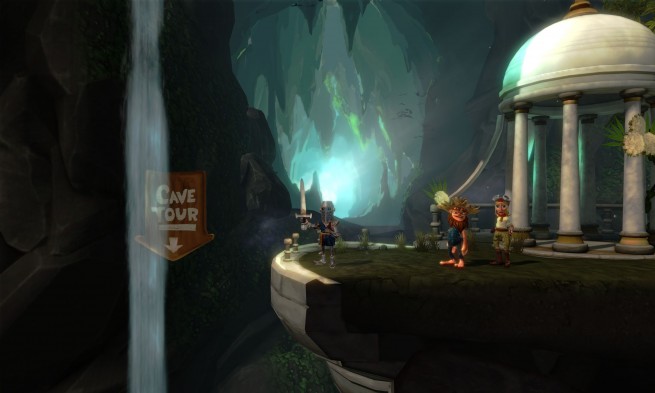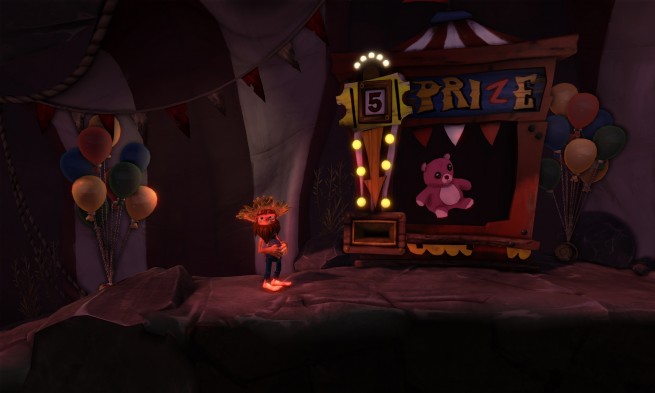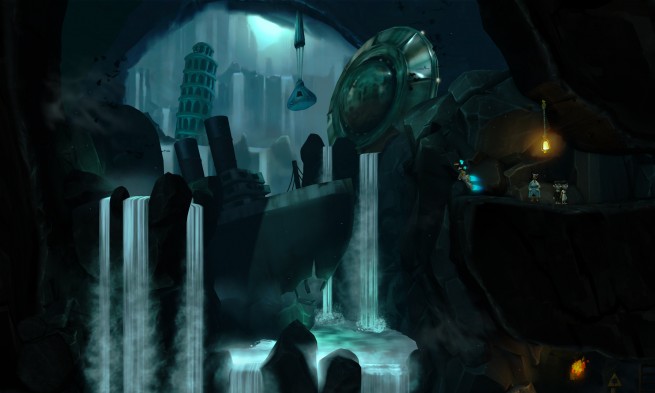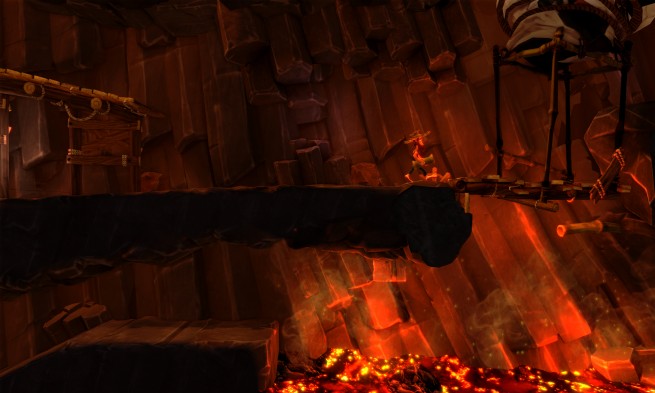Maniac Mansion and DeathSpank designer Ron Gilbert’s first game since joining forces with Double Fine Productions is nearing its January 2013 release. The Cave, a downloadable platforming-adventure game, calls on Gilbert’s history-making, puzzle-heavy adventure titles, albeit with the added magic of Double Fine’s signature and imaginative art style. At a recent preview event in San Francisco, I had the chance to go hands-on with an entire area of the game — an underground carnival — as well as sit down with Gilbert himself to talk about The Cave and his thoughts on digital distribution over traditional retail.
In The Cave, players choose three of seven characters whom they control for the rest of the game — no changies! The titular cave leads to various standalone areas that only certain characters can access. My demo, for example, took place in the Hillbilly character’s unique location, the underground carnival. Reaching and then ultimately escaping this area required the Hillbilly’s ability to hold his breath while the other two characters rarely lent support by holding an object or standing on a pressure plate, and so on.
The carnival and its puzzles were amusing and challenging without being especially compelling or disheartening, respectively. That is to say, I wasn’t bored or frustrated out of my mind, but I also didn’t really care about what I was doing. To be fair, that may be because I dropped into the middle of a game with no context for who the characters are and what they’re doing. I found that instead of sitting still and trying to think my way through puzzles, I would eventually figure some of the tougher mind-benders out just by running around the area and trying out various things. Eventually, a light bulb would click, and I’d go running back to try a new solution. That said, some of the other game journalists near me got stumped pretty hard and were still trying to work their way out of the carnival after I had finished my demo, my 15-minute interview, and eaten a bunch of publisher Sega’s free food.
The lack of online co-op is, without a doubt, The Cave’s biggest fault.
I was left feeling like The Cave is a very niche title that likely won’t appeal to many modern gamers, nor does it necessarily need to — something Gilbert and I discuss below. Part of that comes down to what I felt were fairly important missing features, like a map, though the lack of online co-op is, without a doubt, the biggest detriment. The Cave features local co-op for up to three players, but this feature is more annoying than helpful since players would often need to split up and multitask to make cooperative multiplayer worthwhile — something they can’t do when sharing a single screen.
Despite my issues with the game, I still look forward to teaming together the Twins, the Time Traveler, and the Knight and seeing where our subterranean adventure takes us.
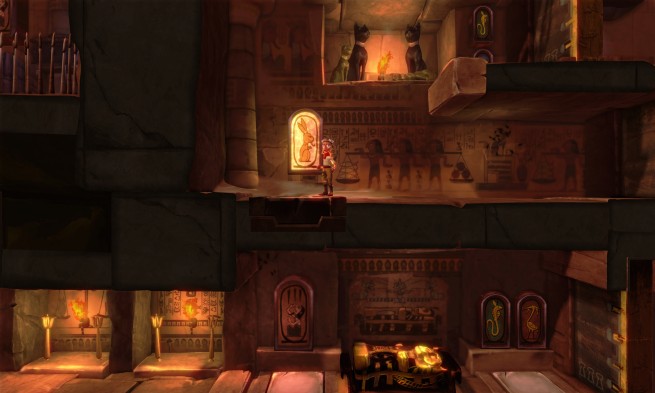
GamesBeat: When you’re making a game that’s drop in, drop out, it seems like if you’re playing by yourself, the A.I. characters just stand there. Did you consider having them follow you around originally?
Gilbert: We talked about that early on. We decided not to do that because … a lot of times, you’re positioning people for a reason. You want this character to stand over here because you’re going to need him to turn the generator on and off or something like that. The last thing you want is the characters following you around [when you intentionally left them at a certain spot].
We talked about how maybe there’s some way you can tell them to stay or tell them to follow. It just started to get into this really complicated system. We wanted everything to be as simple as possible. There are points in the game where characters do catch up with you. If there’s really nothing else to do over here, we do pull the characters in the other direction. You don’t see that in this little section.
GamesBeat: There was one in this demo. After you blow up the dynamite and go down to the carnival, they catch up.
Gilbert: Yeah. There’s a lot more of that in the game. There are places where we’re gathering up the characters [and] we realize that there’s nothing for them to do around there. But we wanted to keep things as simple as possible. Having a control mechanism for telling people to wait or follow or whatever just seemed like too much.
GamesBeat: Just for a sense of understanding, what percentage would you say this stage was of the entire game?
Gilbert: I don’t know. Five percent, maybe? Each character has their own areas, but then there’s the whole rest of the cave that you’re exploring that’s made up of common areas.
GamesBeat: Do the common areas use multiple characters’ special abilities?
Gilbert: Yeah, they do.
GamesBeat: Eventually, I gathered all the items in the carnival together. I gathered them all by the two-legged lady, just so I knew where they are because I lost the wrench. [Laughs] I left it on the weight platform, and I couldn’t see it. Even just this small area is pretty large, so did you consider having a map feature where it would identify objects or points of interest?
Gilbert: Yeah, these are all things we’ve talked about. At the same time, we’re talking about other stuff. We opted for simplicity. We did a lot of testing with people — seeing where they were confused or not confused. The objects have the little text that floats above them. We felt that was probably OK. We weren’t seeing a lot of issues with that. Again, we just opted for simplicity in a lot of this stuff.
GamesBeat: This isn’t so much a question but my personal experience with the demo. I got through everything pretty well. There were places I got stumped for a few minutes. But if you just run around in circles and try different things, eventually you’ll think, “Oh, that makes sense.” At the end, though, turning off the fire hose … I originally dunked the monk. The monk can’t swim that long, so he went the way he was supposed to instead of going and exploring the hidden underwater path. I had no way of naturally knowing. It was easier to miss than a lot of other things and didn’t feel like an intuitive solution. The question out of that is, do you worry about getting to a point where maybe some of your audience gets stumped and gets frustrated and doesn’t come back?
Gilbert: No, not particularly. Adventure games are about being stumped. There’s a certain amount of enjoyment that comes from going, “Wow, how do I figure this out?” And then there’s the “A-ha!” moment for people, when the pieces finally all fall into place. For that particular puzzle … maybe you finally get the Hillbilly to swim down there, and you have that “A-ha!” moment as you realize, “Wow, there’s a whole ‘nother area down here that I couldn’t get to.” But I think that just comes with the territory with adventure games. I tried to steer away from mind-boggling classic adventure-game puzzles that you’d spend days trying to figure out. I really tried to stay away from that. With the kind of mass appeal that games are having today, the kind of people that are playing them, I wanted to shy away from that. But I also didn’t want to make everything just a gimme puzzle, something that’s just a matter of, “Oh, here it is, this is what I do with it” — where the puzzle-solving is really just about pushing buttons. So there are some things, like the fire, that are going to be a bit challenging for people. And there are much harder things in the game besides that.
GamesBeat: I think you were just touching on it a bit, but … old-school PC games and 8-bit games, they were hard. Earthworm Jim was hard. People think back and remember a game like that and think, “Earthworm Jim was so much fun!” But that game was mind-boggling difficult, and it certainly wasn’t alone. But as time has progressed, it seems like people have become … they don’t want a challenge. If a game’s too hard, they say, “I’m done, I’m gonna go play Call of Duty multiplayer” or whatever. How do you feel about that that as far as designing adventure games?
Gilbert: I think it’s something you have to pay attention to today when you’re designing games. Like you say, everybody loves the classic games. Everybody loves Monkey Island. But if Monkey Island was released today, people would hate it. It would be way too hard for people to play. So I think you do have to be conscious of that as things change. There’s some of that in The Cave. There’s a lot of simplification we did. Not having inventory and things like that. We geared that towards the play style of a lot of gamers today. Because there are so many things pulling our attention, with social media and movies in our homes and games. You have to make sure that you’re keeping people engaged in this stuff. But on the other hand, I didn’t want to make it so simple that it wasn’t challenging for people who do enjoy that kind of thing.
GamesBeat: Were there any characters that didn’t make the cut?
Gilbert: Yeah, there was a lot. I started out with about 30 characters on a whiteboard. I listed them all out. I listed little four- and five-word descriptions of their stories and what their special abilities would be. Then, I went through and started cutting them. [Like the mobster.] His abilities just weren’t that interesting. His story wasn’t that interesting. So we cut him and replaced him with the monk. That was something that happened. We hadn’t done a whole lot of work on sculpting his world out yet, but we’d done a lot of design.
GamesBeat: What was his special ability?
Gilbert: He was very strong. So it’s a good example of cutting in and putting in someone else that’s more interesting.
GamesBeat: Sega and Double Fine have both taken a particular interest in downloadable titles lately. Just recently Sega released Virtua Fighter 2, Sonic the Fighters, and Fighting Vipers on Xbox Live Arcade for five dollars each, with online play and achievements. They’ve been doing that a lot. And Double Fine, with Amnesia Fortnight, they switched away from long-lead games like Brüttal Legend and Psychonauts. What draws you personally to digital?
Gilbert: The hard truth is that I think physical media is dead. It just doesn’t know it yet. We live in a world where most people have broadband at home. They want to instantly buy things. They don’t even want to drive down to the store. They want to push a button on their Xbox or their PC and buy stuff. You see the huge success of Steam coming around. Movies … . I haven’t been to a video rental store in maybe five years.
GamesBeat: Not even a Redbox?
Gilbert: No. Everything is just through my Apple TV. I just rent everything on iTunes. That’s just the future. Physical media is just going to do less. I think downloadable is going to be the way we are.
GamesBeat: You’ve done a string of downloadable arcade-type games. Do you have plans or hopes to work on a larger console game even if it’s downloadable?
Gilbert: I like smaller games. I like smaller development cycles. I don’t like being tied up in something for three years. I like working with smaller teams of people. It’s a lot more intimate and a lot more creative and a lot more improv-y in the things you can do. When you’re working with a team of 100 people … to me, it’s just a lot less fun. I like the downloadable stuff because it tends to be smaller. The playtimes are shorter. But that’s OK because you’re packing more excitement per minute into that eight or 10 hours. That’s the way to go. I like them not because they’re digital — I like them because of the size and because of the experience they tend to give to people.
VentureBeat's mission is to be a digital town square for technical decision-makers to gain knowledge about transformative enterprise technology and transact. Learn More
